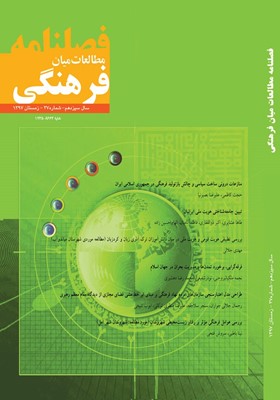فرقهگرایی، برخورد تمدنها و مدیریت بحران در جهان اسلام
محورهای موضوعی : مطالعات میان فرهنگینجمه ملکیان بروجنی 1 , نوذر شفیعی 2 , محمدرضا دهشیری 3
1 - دانشجوی روابط بین الملل، دانشگاه آزاد واحد تهران شمال، تهران، ایران
2 - دانشیار روابط بینالملل دانشگاه اصفهان
3 - دانشیار علوم سیاسی دانشکده روابط بین الملل وزارت امور خارجه
کلید واژه: فرقهگرایی, جهان اسلام, جنگ تمدنها, جنگ فرقهای,
چکیده مقاله :
بحران در جهان اسلام عوامل و اشکال زیادی دارد و بسیاری ریشۀ آن را از دریچۀ فرقهگرایی مورد تحلیل قرار میدهند؛ بهنحویکه فرقهگرایی را چه بهصورت فعال و یا غیرفعال، شاخصترین بحران در دنیای اسلام قلمداد میکنند. هدف اصلی این مقاله بررسی منشأ فعال شدن فرقهگرایی در دنیای اسلام در سطح کلان است. این پژوهش با طرح این سؤال که چه عواملی باعث فعال شدن فرقهگرایی و ظهور و بروز آن در شکل درگیریهای فرقهای در جهان اسلام شده بهگونهای که آن را به یک بحران مسلط در این پهنه تبدیل کرده است؟ به ارزیابی این فرضیه می پردازد که نظم سیاسی بینالمللی اقتضا می کند فرقهگرایی بهعنوان یک بحران مزمن (غیرفعال) در دنیای اسلام در راستای اهداف نظم سیاسی بینالمللی فعال شود. این پژوهش ازنظر هدف کاربردی و ازنظر روش تحلیلی- تبیینی است. ابزار گردآوری اطلاعات، فیشبرداری و پرسشنامه و روش تجزیهوتحلیل اطلاعات کمی و کیفی و بر اساس چارچوب نظری جنگ تمدنهای هانتینگتون و طیف لیکرت استخراجشده است. یافته نظری پژوهش آن است که پدیدههای داخلی، منطقهای و بینالمللی قابل دستکاری و مدیریت هستند و یافته کاربردی هم به این موضوع برمیگردد که جهان اسلام باید با تقسیم و توزیع قدرت سیاسی متناسب با بافت اجتماعی کشورها که نزدیکترین راهحل به نظر میرسد در جهت رفع این عارضه اقدام کند.
The crisis in the Islamic world has several aspects and would be analyzed as the origin of the sectarianism. Somehow, the sectarianism either active or inactive was considered to be the most significant crisis in the Muslim world. The main purpose of this study is to investigate the origin of the activation of sectarianism at the strategic level. Thus, the international political order requires the activation of the sectarianism in order to achieve their goals. This research is applied and analytical-explanatory type. The note-taking and questionnaire method used for collecting the information and quantitative and qualitative used to analyze this information and is based on the theoretical framework of the clash of civilizations and the Likert scale. The theoretical findings of this research are that domestic, regional, and international phenomena can be manipulated and managed, and applied results also suggest that the Islamic world should be divided and distributed according to the political power of countries depending on the social structure of countries, which seems to be the explicit solution, In order to eliminate this complication.
استونز، راب. (1379). متفکران بزرگ جامعهشناسی، میردامادی، تهران: مرکز، چاپ اول.
سآرون، ریمون. (1372). مراحل اساسی اندیشه در جامعهشناسی، پرهام، تهران: سهامی، چاپ سوم.
چرنوف، فرد. (1390). نظریه و زبرنظریه در روابط بینالملل (مفاهیم و تفسیرهای متعارض)، ترجمه علیرضا طیب، تهران: نشر نی.
دورکیم، امیل. (1369). درباره تقسیمکار اجتماعی، ترجمه باقر پرهام، چاپ اول، تهران: انتشارات نقش جهان.
دورکیم، امیل. (1373). قواعد و روش جامعهشناسی، ترجمه علیمحمد کاردان، چاپ پنجم، تهران: موسسه انتشارات و چاپ دانشگاه تهران.
رضائی، علیرضا (1389). «الگوی روسیه از نظم در نظام بینالملل پساجنگ سرد: نظم موازنه محور»، فصلنامه مطالعات سیاسی، 7 بهار.
کلینتون، هیلاری (1394). انتخابهای سخت، ترجمه امیر قادری، تهران: انتشارات ملیکان.
Berger, P. L (1954). The sociological study of sectarianism. Social Research, 467-485.
Bush, George (1991). "Address Before a Joint Session of the Congress on the State of the Union," January 29, 1991. Online by Gerhard Peters and John T. Woolley, the American Presidency Project. http://www. presidency.ucsb.edu/ws/?pid=19253.
Cox, Robert, W (1981). Social Forces, States and World Orders: Beyond International Relations Theory, Millennium 10, No. 2 (June 1).
Fukuyama, Francis (1992). The End of History and the Last Man, New York: Free Press, 2006, pp. xi, 43-51.
Gilpin, Robert (1981). War and Change in World Politics, Cambridge, UK: Cambridge University Press.
Guzzini,S (2000). A Reconstruction of constructivism in International Relations, European Journal of International Relations, 6:1477
Hall, Stuart (1997). The Work of Representation, In Cultural Representation and Signifying Practice, Sage Publication, pp 24-25
Huntington, Samuel (1996). The Clash of Civilizations and the Remaking of World Order, New York: Simon & Schuster, 1996, pp. 13, 19-21.
Huntington, S. P (1997). The Clash of Civilizations and the Remaking of World Order. 1996. Polish Edition MUZA SA.
Ikenberry, John (2001). After Victory: Institutions, Strategic Restraint, and the Rebuilding of Order After Major Wars, Princeton, NJ: Princeton University Press, 2001.
Ikenberry, John (1999). “Institutions, Strategic Restraint, and the Persistence of American Postwar Order,” International Security, Vol. 23, No. 3, Winter, 1998-99, pp. 43-78;
Lijphart, Arend (1999). Patterns of Democracy. New Haven and London: Yale University Press.
Lijphart, Arend (1969). Cosociational democracy, World Politics / Volume 21 / Issue 02 / January 1969, pp 207-225
Mellon, James, G. (2001). Islam and International Politics: Examining Huntington’s “Civilizational Clash” Thesis. Totalitarian Movements and Political Religions, No. 2 (V. 1)
Waltz, Kenneth N. (1959). Man, the State and War: A Theoretical Analysis, New York: Columbia University Press.
Watson, James and Hil (2006). Anne. Dictionary of Media and Communication Studies, 7th Edition, Hodder Arnold Publication, pp248.
_||_

